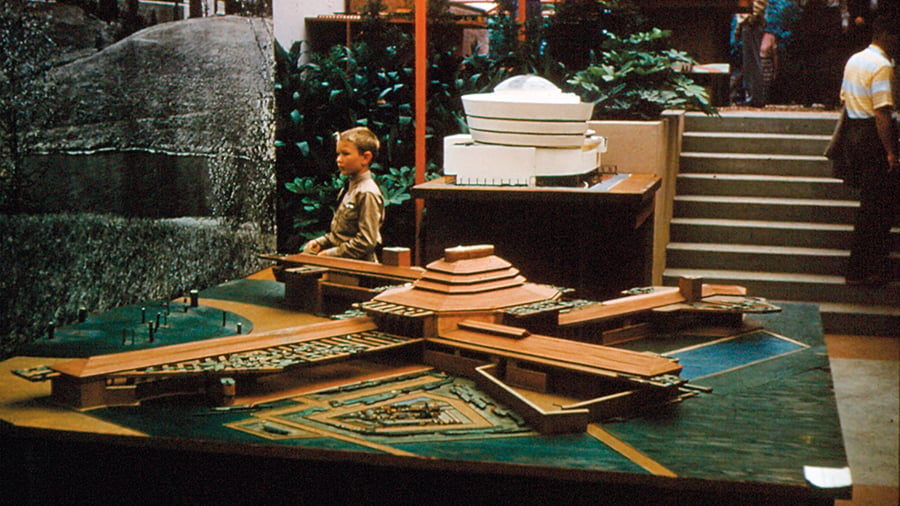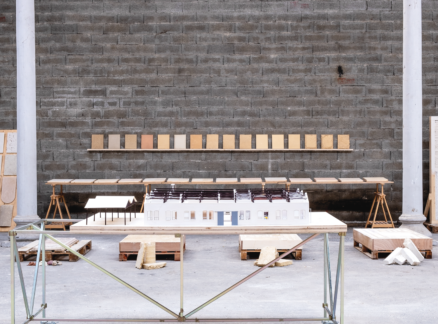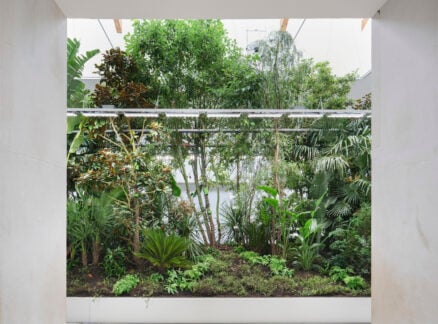
June 7, 2017
Philosophy on Exhibit: How Wright Brought His Biggest Ideas to the World
A new book chronicles the 100 exhibits Wright designed throughout his career. This excerpt introduces us to some of the giant ideas America’s first real starchitect wanted his public to embrace.
In the 2011 documentary John Portman: A Life of Building, the iconic urban developer/architect Portman tells a story about once meeting Frank Lloyd Wright and asking for career advice. Wright could have responded a thousand different ways, of course, but his answer would resonate with Portman for the rest of his days. Wright replied, “Young man, go seek Emerson.”
Wright was the ultimate idea man. He loved asking people—and not just architects—to broaden their perceptions of nature, the built environment, and the way societies operate day-to-day. “He was trying to raise the consciousness of the American people, beyond the pursuit of money or the acquisition of what we’d call consumer goods,” says Wright scholar Kathryn Smith. “He wanted to be a great motivating force for them.”
Smith has just written a new book about Wright’s efforts to educate and influence a worldwide audience. In Wright on Exhibit (Princeton University Press, 2017), she describes how Wright created over 100 exhibits, from 1894 to 1969, to get his message out.
[Wright] became conscious of his destiny to employ his buildings symbolically to communicate ideas. His use of common words—nature, democracy, and organic—as Platonic ideals, which necessitated capitalization, gave them new meaning, which was not readily self-evident. Nature, Democracy, and Organic, while seemingly distinct, all shared one meaning in Wright’s mind.
Democracy was founded in America because it was conceived in pristine Nature, but by this Wright was not referring to flora and fauna. Rather, he meant “that inner harmony which penetrates the outward form…and is its determining character; that quality in the thing that is its significance and its Life for us—what Plato called…the ‘eternal idea of the thing.’” For instance, for him Democracy was an imaginary landscape or state of consciousness where the not-yet could be the now, eventually he called this Utopia, Broadacre City.
Like neo-Platonists, Wright believed that concealed beneath the fractured and disordered surface of modern life lay a harmony and order—a latticework of logical and mathematical relations that demonstrated the natural laws of the universe and the power of the Divine, a Platonic notion of an ideal realm more real than his own perceived world. Geometry, proportion, and scale present in his design could elucidate the transcendental order of the universe, thus revealing the new truth. In this sense, the fabrication and display of the Broadacre City model as a representation of Democracy with its commanding physical form was a distraction from the more philosophical meaning found only in his writings.
Wright assumed the role of the nonconformist, who distrusted organized religion, education, and politics. He believed his inner conscience guided his actions and overrode institutions, it was his role to speak the truth even when it was offensive; in fact, the shock was meant to rouse people out of their passivity. Wright’s unrelenting critique of American buildings and cities was just one side of a coin; on the reverse was his eternal optimism that reform was possible if the American people could rise up and overturn the status quo.
By showing in a museological setting, Wright sought to reach past the architectural profession to educate the public. To this end, he maintained his independence, for the most part, by financing his own exhibitions: he provided his own drawings and models, and to a lesser extent, photographs; he paid for shipping and the expenses of an apprentice to supervise the installation and act as a guide; and, in many instances, he funded self- generated publications that he intended to elucidate the shows…
In the period before and after World War II, Wright benefitted from the power and reach of the Museum of Modern Art. Despite his temperament, he had more exhibitions at MoMA’s Manhattan venue and across the nation under the auspices of its well-organized Department of Circulating Exhibitions than any other artist. The museum curators—McAndrew, Drexler, and Johnson—immediately recognized the architectural importance of such disparate buildings as Fallingwater, SC Johnson Administration Building and Research Tower, and Taliesin and Taliesin West by selecting them for single building shows for presentation to the public.
In the postwar period, the variety and complexity of Wright’s monumental architecture as well as his humanist theoretical position challenged American modern architecture as it became increasingly institutionalized, lapsing into banality. Wright’s Manhattan exhibitions were covered by the press, which led to even greater awareness by the architecture profession and the general public. With increased exposure through the new media of radio and television, he became the first “starchitect,” perhaps the epitome of the term: an icon, a great hero of popular culture.
Wright’s longevity made possible the immense impact of his exhibitions in the 1950s, he lived to within months of his ninety-second birthday and was an advocate and activist until the end.
–from Wright on Exhibit by Kathryn Smith (Princeton University Press, 2017)
Recent Viewpoints
Viewpoints
Sustainability News Updates for Q2 2025











